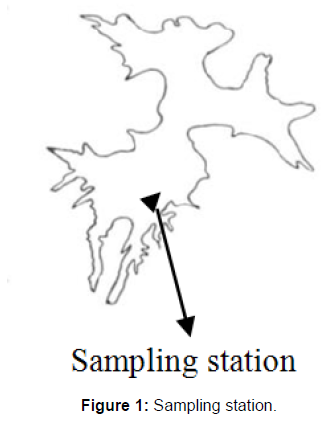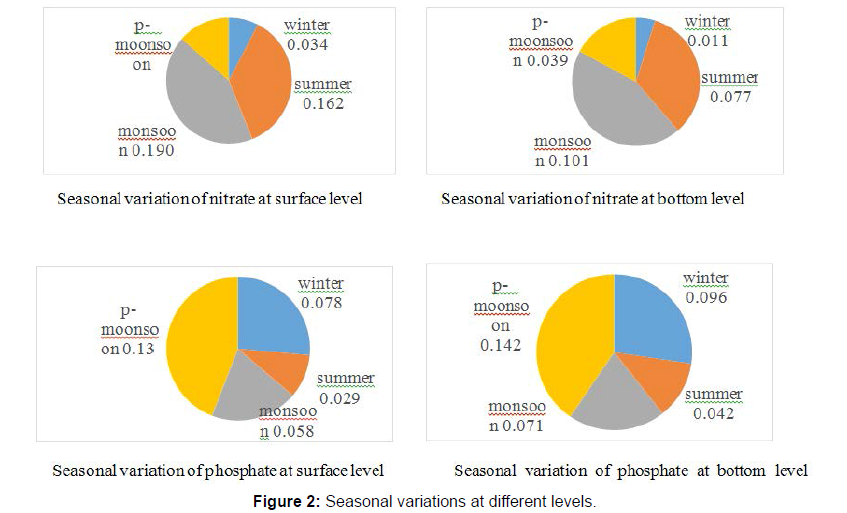Trophic Status in Freshwater Lentic Ecosystem of Halali Reservoir (Vidisha-MP, India) with Special Focus on Nitrate and Phosphate
Received: 28-Jan-2021 / Manuscript No. jee-21-25263 / Editor assigned: 01-Feb-2021 / PreQC No. jee-21-25263 (PQ) / Reviewed: 11-Feb-2021 / QC No. jee-21- 25263 / Revised: 03-Jan-2022 / Manuscript No. jee-21-25263(R) / Accepted Date: 10-Jan-2022 / Published Date: 10-Jan-2022 DOI: 10.4172/2157-7625.1000311
Abstract
Nitrate and phosphate are the two key nutrients required by plants and animals to perform certain necessary functions. Accelerated anthropogenic activities (via use of nitrate and phosphate based compounds) and processes like runoff from sewerage, agricultural and construction sites; septic tank leachate; runoff and infiltration from animal feedlots etc. brings large quantities of such nutrients into the nearby water bodies and support the luxurious growth of algae and other aquatic plants like Hydrilla, Ceratophylum, Vallisneria spiralis etc. which alternately make the water eutrophic and cause the gradual shrinking of the water body. The excessive growth of these aquatic plants causes some more complicated conditions like reduced light penetration, low DO and also snatches the aesthetic value of the aquatic system and ultimately reduces its life span to a large extent.
Keywords: Halali reservoir; Seasonal variation; Physico-chemical parameters; Runoff; Nutrient uptake; Nitrate; Phosphate
Keywords
Halali reservoir; Seasonal variation; Physico-chemical parameters; Runoff; Nutrient uptake; Nitrate; Phosphate
Introduction
Reservoirs are not only a significant source of precious water but also provide a valuable habitat to the aquatic world. Madhya Pradesh has 3.0 lakh ha of water area in the form of reservoirs and ponds out of which 2.50 lakh ha are in the form of reservoirs and 0.50 lakh ha is in the form of village ponds [1]. The contamination of water bodies with excessive amount of inorganic nitrogen and phosphorus from fertilizer runoff is a pressing concern, though they give the prevalence of agriculture but alternately results in large proliferation of algae which have detrimental effects on the aquatic biota [2].
Nitrate is final product of mineralization process [3] which is colourless, odourless and tasteless compound. Phosphorus is present in different forms among which orthophosphate is the soluble reactive from of phosphorus which is also termed as inorganic phosphate. It plays a dynamic role in aquatic ecosystem which is taken up widely by phytoplankton [4].
Materials and Methods
The present study was carried out on Halali reservoir (Vidisha, India) which is a source of different fish varieties (Catla catla, Rohu, Mrigal, Wallago attu, Mystus and Chitala). It is built on the river Halali which is 40 kms away from the Bhopal City.
The reservoir was constructed in 1976, with catchment and water spread area of 699 km2 and 5959 ha, shoreline 65 kms and maximum depth of 29.5 m.
Water samples were collected seasonally during the morning hours (9 to 11 am) from surface and bottom in winter (January), summer (April), monsoon (July) and post-monsoon (October) 2011 at Patra Nala that was selected as sampling station through which the drainage waste of Bhopal city enters the reservoir. Besides domestic discharge, the Nala also receives wastes from textile, distillery and straw product factories of Bhopal. Water samples were analysed as per APHA [5] and A.D Adoni [6] (Figures 1 and 2).
Results and Discussion
The results about nine physico-chemical parameters of water are listed in Table 1. During the period of study the nitrate concentration was recorded maximum in monsoon which may be due to heavy downpour and subsequent runoff from surrounding agricultural fields but this level is below the USEPA’s [7] Maximum Contaminant Level (MCL) of 10 mg/l, and minimum value of nitrate was recorded in winter which may be due to very minimum runoff from surrounding fertilizer fed agricultural fields which drains everything into the nearby water body. Nitrate (NO3) is not dangerous for the health unless it is changed to nitrite (NO2). Hannan and Young [8] has shown that early monsoon runoff is an important contributor of nitrate-nitrogen to the reservoir.
| Season | Parameter | ||||||||
|---|---|---|---|---|---|---|---|---|---|
| Water temp (oC) | Transp. | Free Co2 | pH | DO | P alkalinity | Nitrate | Phosphate | Air temp (oC) | |
| Winter | S 23.6 | 124 cm | S 3.41 | S 7.5 | S 7.14 | Nil | S 0.034 | S 0.078 | 26.2 |
| B 17.3 | B 2.77 | B 7.1 | B 7.9 | Nil | B 0.011 | B 0.096 | |||
| Summer | S 29.4 | 78 cm | Nil | S 8.2 | S 6.8 | S 24.1 | S 0.162 | S 0.029 | 37.6 |
| B 22.7 | Nil | B 7.8 | B 4.4 | B 19.7 | B 0.077 | B 0.042 | |||
| Monsoon | S 26.1 | 46 cm | S 2.67 | S 7.3 | S 8.1 | Nil | S 0.190 | S 0.058 | 31.5 |
| B 18.6 | B 1.48 | B 6.7 | B 6.4 | Nil | B 0.101 | B 0.071 | |||
| P-monsoon | S 19.4 | 67 cm | S 3.97 | S 7.1 | S 8.8 | Nil | S 0.060 | S 0.130 | 22.9 |
| B 16.1 | B 2.71 | B 6.9 | B 7.1 | Nil | B 0.039 | B 0.142 | |||
Table 1: Seasonal variation of Physico-chemical parameters of Halali Reservoir.
High concentration of phosphorus in an aquatic system is an alarm of turning the system towards the eutrophic state. USEPA [7] has suggested 0.08 ppm as a critical level for the occurrence of eutrophication in a water body which is less than the mean value found during the present study. The amount of phosphate in the Halali reservoir may be because of the presence of certain macrophytes (Ipomoea, Vallisneria, Potamogeton, Hydrilla etc.) and sediments drained by surface runoff to the reservoir.
The role of phosphorus in algal growth and eutrophication has been studied by Peterson [9]. The maximum value of 0.130 mg/L at surface and 0.142 mg/L at bottom were recorded in post-monsoon which could be due to huge quantity of domestic sewage, cattle dung, detergents, organic wastes of plant-animal origin, phosphate based detergents and NPK fertilizers. The lower values of phosphate was recorded in summer which may be because of minimum surface runoff and higher temperature that increases the metabolic activity of microbes picking up more and more nutrients from water body. Another reason may be huge quantity of nutrient uptake by inhabited macrophytes (Ipomoea, Vallisneria, Potamogeton, Hydrilla etc.) in the reservoir. The phosphate and nitrate content of Shahpura lake (Bhopal) was found in the range of 6.05 to 9.21 ppm and 2.02 to 15.22 ppm [10]. Enrichment of water body with phosphate may be attributed to the cumulative action of disintegration of phosphate bearing rocks and their subsequent washing and from surrounding catchments making use of phosphate based compounds (e.g., fertilizers) during rainy season. Phosphates also get released by the rocks lying at the bottom and by the death of plants and animals present in the reservoir by various hydrological processes. Phosphate is considered to be the most significant among the nutrients responsible for eutrophication- a condition characterized by growth of algae and weeds in a water body.
Eutrophication signifies the ageing of a water body. Nutrient enrichment causes variations in aquatic systems which results in the growth of primary production to nuisance properties [11]. The main cause is excessive loading of phosphorus and nitrogen into the system resulting in high algal biomass, dominance by cyanobacteria and loss of macrophytes [12].
Entrance of nutrients in a water body and the subsequent aftermath:
Increasing load of nutrients in an aquatic system can lead to the following consequences:
1. Aquatic vegetation can be due to increasing load of nutrients which enhances the growth of macrophytes like- Vallisneria, Potamogeton, Ipomoea, Ceratopylum etc.
2. Low DO content of water body creates anaerobic condition, suitable for growth of pathogenic microbes that makes water unfit for different utilities.
3. Nutrient rich water requires efficient machinery (high cost) for removal of nutrients to make it suitable for different uses.
4. Concentration of nitrates above 10 mg/L (USEPA-MCL) cause methaemoglobinemia, also known as ‘blue baby syndrome’.
5. Decomposition of nutrients like nitrate and phosphate cause foul smell
. 6. The higher levels of nitrate and phosphate in an aquatic ecosystem might be responsible for the development of water bloom by Microcystis aerogenosa. The toxins and chemicals released by it can kill the inhabited fishes, migratory birds and other aquatic animals of the very aquatic ecosystem.
References
- Tamot P, Mishra R, Somdutt (2007) Water quality of the Halali reservoir with reference to cage aquaculture as a modern tool for obtaining enhanced fish production. Proceedings of Taal. The 12th world lake conference: 318-324.
- Freeman, Scott (2002) Biological Science. Upper Saddle River: Prentice Hall.
- Nema P, Rajgopalan S, Mehta CG (1984) Quality and treatment of Sabarmati river water Ahmadabad. JIWWA 16: 99-107.
- Goldman CR (1965) Primary productivity and limiting factors in the lake of the Alaska Peninsula. Ecol Monogr 30: 207-230.
- APHA (1998) Standard methods for the examination of water and waste water 20th addition. American Public Health Association, Washington. Aquaculture Engineering 19: 119-131.
- Adoni AD (1985) Work book of Limnology. Pratibha publication. Sagar MP, India.
- U.S Environmental Protection Agency (1976) Quality criteria for water (report number EPA- 440/9-76-023). Washington, D.C U.S. Environmental Protection Agency.
- Hannan HH, Young WJ (1975) The influence of a deep storage reservoir on the Physico-chemical limnology of a central Texas river. Hydrobiologia 44: 177-207.
- Peterson JB, Barlow JP, Savage (1974) The physiological state with respect to phosphorus of Caynga lake phytoplankton. Limnol. Oceanogr 19: 396-408.
- Dixit S, Gupta SK, Tiwari S (2005) Nutrient Overloading of a Freshwater Lake in Bhopal, India. Electronic Green Journal.
- Marsden MW (1989) Lake restoration by reducing external phosphorus loading: the influence of sediment phosphorus release. Fresh Water Biology 21: 139-162.
- Jana BB, Das SK (1995) Phosphorus in aquatic system: An overview. In PC Mishra, N Behera, BK Senapati and BC Guru (Eds.) Advances in Ecology and Environmental sciences. New Delhi, India.
Indexed at Google Scholar Crossref
Indexed at Google Scholar Crossref
Indexed at Google Scholar Crossref
Citation: Gul I (2022) Trophic Status in Freshwater Lentic Ecosystem of Halali Reservoir (Vidisha-MP, India) with Special Focus on Nitrate and Phosphate. J Ecosys Ecograph 12: 311. DOI: 10.4172/2157-7625.1000311
Copyright: © 2022 Gul I. This is an open-access article distributed under the terms of the Creative Commons Attribution License, which permits unrestricted use, distribution, and reproduction in any medium, provided the original author and source are credited.
Select your language of interest to view the total content in your interested language
Share This Article
Recommended Journals
Open Access Journals
Article Tools
Article Usage
- Total views: 2433
- [From(publication date): 0-2022 - Dec 08, 2025]
- Breakdown by view type
- HTML page views: 1726
- PDF downloads: 707


